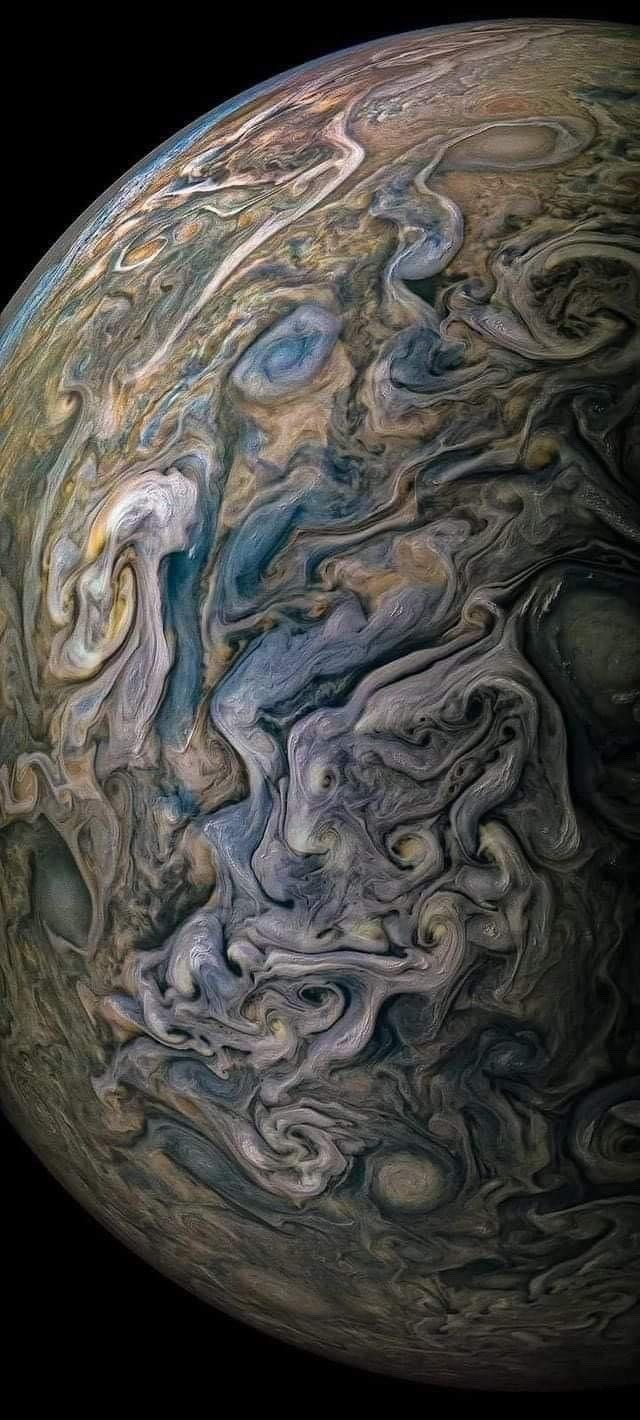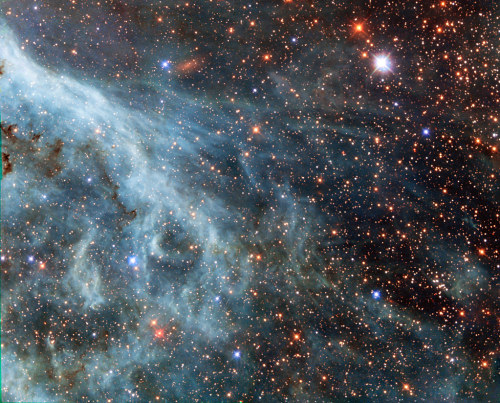The Misconception That There Is No Sound In Space Originates Because Most Space Is A ~vacuum, Providing
The misconception that there is no sound in space originates because most space is a ~vacuum, providing no way for sound waves to travel. A galaxy cluster has so much gas that we've picked up actual sound. Here it's amplified, and mixed with other data, to hear a black hole!

More Posts from Of-finite-jurisdiction and Others
the new composite james webb image is so beautiful ive been staring at it for 10 minutes straight

featuring jupiters rings, europa (along with a bunch of other moons), the northern and southern auroras, and the great red spot

Chamaeleon Dark Nebulas : Sometimes the dark dust of interstellar space has an angular elegance. Such is the case toward the far-south constellation of Chamaeleon. Normally too faint to see, dark dust is best known for blocking visible light from stars and galaxies behind it. In this four-hour exposure, however, the dust is seen mostly in light of its own, with its strong red and near-infrared colors giving creating a brown hue. Contrastingly blue, the bright star Beta Chamaeleontis is visible just to the right of center, with the dust that surrounds it preferentially reflecting blue light from its primarily blue-white color. All of the pictured stars and dust occur in our own Milky Way Galaxy with – but one notable exception: the white spot just below Beta Chamaeleontis is the galaxy IC 3104 which lies far in the distance. Interstellar dust is mostly created in the cool atmospheres of giant stars and dispersed into space by stellar light, stellar winds, and stellar explosions such as supernovas. via NASA
SNOOPY IS BACK FROM THE MOON






The Clearest Images of Jupiter ever taken
These beautifully real images are some of the closest images of Jupiter. Jupiter is the fifth planet from the Sun and the largest in the Solar System. It is a gas giant with a mass more than two and a half times that of all the other planets in the Solar System combined, but slightly less than one-thousandth the mass of the Sun. The original image was captured by JunoCam, the camera on NASA's Juno mission in orbit around Jupiter. This image was taken on Juno's 22nd close pass by Jupiter on Sept. 12, 2019 with image processing done by Prateek.
📸: NASA's Juno Space Probe / JunoCam

Spiral Galaxy NGC 2841 : A mere 46 million light-years distant, spiral galaxy NGC 2841 can be found in the northern constellation of Ursa Major. This deep view of the gorgeous island universe was captured during 32 clear nights in November, December 2021 and January 2022. It shows off a striking yellow nucleus, galactic disk, and faint outer regions. Dust lanes, small star-forming regions, and young star clusters are embedded in the patchy, tightly wound spiral arms. In contrast, many other spirals exhibit grand, sweeping arms with large star-forming regions. NGC 2841 has a diameter of over 150,000 light-years, even larger than our own Milky Way. X-ray images suggest that resulting winds and stellar explosions create plumes of hot gas extending into a halo around NGC 2841. via NASA
IS THE UNIVERSE INFINITE??
Blog# 187
Wednesday, April 27th, 2022
Welcome back,
It’s one of the most compelling questions you could possibly ask, one that humanity has been asking since basically the beginning of time: What’s beyond the known limits? What’s past the edge of our maps? The ultimate version of this question is, What lies outside the boundary of the universe?
The answer is — well, it’s complicated.

To answer the question of what’s outside the universe, we first need to define exactly what we mean by “universe.” If you take it to mean literally all the things that could possibly exist in all of space and time, then there can’t be anything outside the universe. Even if you imagine the universe to have some finite size, and you imagine something outside that volume, then whatever is outside also has to be included in the universe.
Even if the universe is a formless, shapeless, nameless void of absolutely nothing, that’s still a thing and is counted on the list of “all the things” — and, hence, is, by definition, a part of the universe.

If the universe is infinite in size, you don’t really need to worry about this conundrum. The universe, being all there is, is infinitely big and has no edge, so there’s no outside to even talk about.
Oh, sure, there’s an outside to our observable patch of the universe. The cosmos is only so old, and light only travels so fast. So, in the history of the universe, we haven’t received light from every single galaxy. The current width of the observable universe is about 90 billion light-years. And presumably, beyond that boundary, there’s a bunch of other random stars and galaxies.
But past that? It’s hard to tell.

Cosmologists aren’t sure if the universe is infinitely big or just extremely large. To measure the universe, astronomers instead look at its curvature. The geometric curve on large scales of the universe tells us about its overall shape. If the universe is perfectly geometrically flat, then it can be infinite. If it’s curved, like Earth's surface, then it has finite volume.
Current observations and measurements of the curvature of the universe indicate that it is almost perfectly flat. You might think this means the universe is infinite. But it’s not that simple. Even in the case of a flat universe, the cosmos doesn’t have to be infinitely big. Take, for example, the surface of a cylinder.

It is geometrically flat, because parallel lines drawn on the surface remain parallel (that’s one of the definitions of “flatness”), and yet it has a finite size. The same could be true of the universe: It could be completely flat yet closed in on itself.
But even if the universe is finite, it doesn’t necessarily mean there is an edge or an outside. It could be that our three-dimensional universe is embedded in some larger, multidimensional construct. That’s perfectly fine and is indeed a part of some exotic models of physics. But currently, we have no way of testing that, and it doesn’t really affect the day-to-day operations of the cosmos.

And I know this is extremely headache-inducing, but even if the universe has a finite volume, it doesn't have to be embedded.
When you imagine the universe, you might think of a giant ball that’s filled with stars, galaxies and all sorts of interesting astrophysical objects. You may imagine how it looks from the outside, like an astronaut views Earth from a serene orbit above.
But the universe doesn’t need that outside perspective in order to exist. The universe simply is. It is entirely mathematically self-consistent to define a three-dimensional universe without requiring an outside to that universe. When you imagine the universe as a ball floating in the middle of nothing, you’re playing a mental trick on yourself that the mathematics does not require.

Granted, it sounds impossible for there to be a finite universe that has nothing outside it. And not even “nothing” in the sense of an empty void — completely and totally mathematically undefined. In fact, asking “What’s outside the universe?” is like asking “What sound does the color purple make?” It’s a nonsense question, because you’re trying to combine two unrelated concepts.
It could very well be that our universe does indeed have an “outside.” But again, this doesn’t have to be the case. There’s nothing in mathematics that describes the universe that demands an outside.
If all this sounds complicated and confusing, don’t worry. The entire point of developing sophisticated mathematics is to have tools that give us the ability to grapple with concepts beyond what we can imagine. And that’s one of the powers of modern cosmology: It allows us to study the unimaginable.
Originally published on https://www.space.com
COMING UP!!
(Saturday, April 30th, 2022)
“WHAT IS THE ELECTRON CLOUD THEORY??”

Turquoise Plumes in the Large Magellanic Cloud by NASA’s Marshall Space Flight Center

oh okay. heart steps right out of my chest and falls down the stairs

Uluru blackh●le rise, me, pixel art, 2022
Don't talk to me right now I'm thinking of the new Jupiter photos and Vincent Van Gogh:







-
 scrimmshander reblogged this · 3 months ago
scrimmshander reblogged this · 3 months ago -
 rahayn reblogged this · 3 months ago
rahayn reblogged this · 3 months ago -
 airshipvalentine liked this · 3 months ago
airshipvalentine liked this · 3 months ago -
 rahayn reblogged this · 3 months ago
rahayn reblogged this · 3 months ago -
 rahayn reblogged this · 4 months ago
rahayn reblogged this · 4 months ago -
 bugmush liked this · 4 months ago
bugmush liked this · 4 months ago -
 voidsverse reblogged this · 4 months ago
voidsverse reblogged this · 4 months ago -
 cosmicsoiree reblogged this · 5 months ago
cosmicsoiree reblogged this · 5 months ago -
 melril reblogged this · 5 months ago
melril reblogged this · 5 months ago -
 nonanthropy reblogged this · 5 months ago
nonanthropy reblogged this · 5 months ago -
 cactusghoti liked this · 6 months ago
cactusghoti liked this · 6 months ago -
 enterthehydra liked this · 6 months ago
enterthehydra liked this · 6 months ago -
 i-wasnt-ready-for-this liked this · 6 months ago
i-wasnt-ready-for-this liked this · 6 months ago -
 whythursdaynext reblogged this · 6 months ago
whythursdaynext reblogged this · 6 months ago -
 thevoidwatches reblogged this · 6 months ago
thevoidwatches reblogged this · 6 months ago -
 gazastriptease liked this · 6 months ago
gazastriptease liked this · 6 months ago -
 biancaicaras reblogged this · 6 months ago
biancaicaras reblogged this · 6 months ago -
 awaywiththe liked this · 6 months ago
awaywiththe liked this · 6 months ago -
 toothlessthecatnoir liked this · 6 months ago
toothlessthecatnoir liked this · 6 months ago -
 theredalice liked this · 6 months ago
theredalice liked this · 6 months ago -
 sarahmeeps liked this · 6 months ago
sarahmeeps liked this · 6 months ago -
 zetti5 reblogged this · 6 months ago
zetti5 reblogged this · 6 months ago -
 zetti5 liked this · 6 months ago
zetti5 liked this · 6 months ago -
 fearlessmastermind reblogged this · 6 months ago
fearlessmastermind reblogged this · 6 months ago -
 fearlessmastermind liked this · 6 months ago
fearlessmastermind liked this · 6 months ago -
 rivinglament liked this · 6 months ago
rivinglament liked this · 6 months ago -
 thevoidwatches liked this · 6 months ago
thevoidwatches liked this · 6 months ago -
 reillygrey reblogged this · 6 months ago
reillygrey reblogged this · 6 months ago -
 captainalexasaurus liked this · 6 months ago
captainalexasaurus liked this · 6 months ago -
 t-dawag93 reblogged this · 6 months ago
t-dawag93 reblogged this · 6 months ago -
 crypticbeastiecritter liked this · 6 months ago
crypticbeastiecritter liked this · 6 months ago -
 katan-a-rama liked this · 6 months ago
katan-a-rama liked this · 6 months ago -
 coolkermitdefrog liked this · 6 months ago
coolkermitdefrog liked this · 6 months ago -
 morthern liked this · 6 months ago
morthern liked this · 6 months ago -
 fiire-flowers reblogged this · 6 months ago
fiire-flowers reblogged this · 6 months ago -
 fiire-flowers liked this · 6 months ago
fiire-flowers liked this · 6 months ago -
 biancaicaras liked this · 6 months ago
biancaicaras liked this · 6 months ago -
 mysticalalleycat liked this · 6 months ago
mysticalalleycat liked this · 6 months ago -
 nihi1ista liked this · 6 months ago
nihi1ista liked this · 6 months ago -
 cosmicsoiree reblogged this · 6 months ago
cosmicsoiree reblogged this · 6 months ago -
 parad0xymoron reblogged this · 6 months ago
parad0xymoron reblogged this · 6 months ago -
 parad0xymoron liked this · 6 months ago
parad0xymoron liked this · 6 months ago -
 nicolefirekitty liked this · 6 months ago
nicolefirekitty liked this · 6 months ago -
 the-schltchrwhocamein-frmthcold liked this · 6 months ago
the-schltchrwhocamein-frmthcold liked this · 6 months ago -
 fishpatrol reblogged this · 6 months ago
fishpatrol reblogged this · 6 months ago -
 nohookstobefoundhere reblogged this · 6 months ago
nohookstobefoundhere reblogged this · 6 months ago -
 nohookstobefoundhere liked this · 6 months ago
nohookstobefoundhere liked this · 6 months ago

Finn OFJ’s space blog. Do you love space?? you better. or else
39 posts